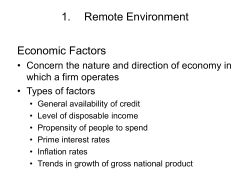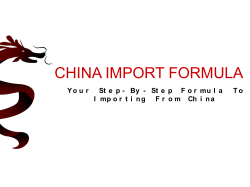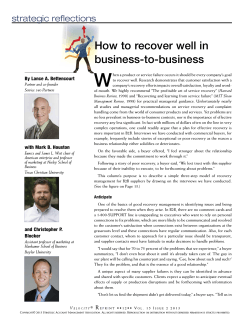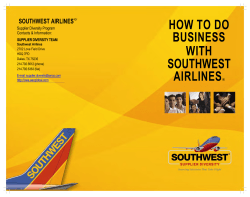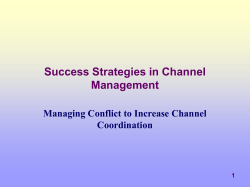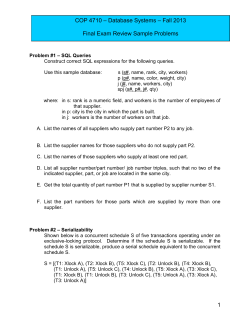
Today: Industry Analysis
Today: Industry Analysis Administrative issues Current Events Porter’s Five Forces Framework How To Analyze Industry Environments Walmart Case Analysis Team assignment Assign new case: RCA Records WEBSITE: www.sba.pdx.edu/faculty/stephens/ss.html The External Environmental Think in terms of Opportunities and Threats the “O” and “T” of TOWS Relate Strategic Objectives to “O” and “T” increased sales and/or market share new product offerings processing technology innovation Continually scan to identify “O’s” and “T’s” The External Environmental The General Environment Demographic: age, ethnicity, household size, occupation Economic: income distribution, inflation, interest rates, exchange rates, urbanization Political/Legal: consumer and environmental protection, unions The External Environmental The General Environment Social and Cultural: conservatism/ liberalism, nesting, materialism Technological: e-tailing, intranets, diffusion rates Global: nationalism, transnational corporations, cultural differences The External Environmental The Industry Environment The following factors in an Industry… Bargaining Power of Buyers Bargaining Power of Suppliers Threat of New Entrants Threat of Substitute Products ...Determine Intensity of Competitive Rivalry The External Environmental The Industry Environment Threat of New Entrants Bargaining Power of Suppliers Competitive Rivalry Threat of Substitute Products Bargaining Power of Buyers The External Environmental Threats of New Entrants decreases if barriers to entry are high... Threat Economies of Scale are high of Product Differentiation is high New Capital Requirements are high Entrants Switching Costs are high Access to Distribution Channels is limited Cost Disadvantages Independent of Scale are high Government Policy is restrictive Expected Retaliation is high The External Environmental Suppliers are likely to be powerful if: Supplier industry dominated by a few firms Suppliers’ products have few substitutes Bargaining Power of Buyer is not important customer Suppliers Suppliers’ product is an important input Suppliers’ products are differentiated Suppliers’ products have high switching costs Supplier poses credible threat to forward integration The External Environmental Buyers are likely to be powerful if: They are concentrated or purchases are large relative to seller’s sales Purchase accounts for a significant fraction of supplier’s sales Bargaining Product unimportant to quality Power Products are undifferentiated of Buyers face few switching costs Buyers Buyers’ industry earns low profits Buyer has full information Buyer presents a credible threat to backward integration The External Environmental The keys to evaluating Substitute Products are: Products with improving price/performance tradeoffs relative to present industry products Threat of Substitute Products For example: Electronic security systems in place of security guards Email and fax machines in place of overnight mail delivery The External Environmental Understanding Competitors Future objectives: goals and risks, ability to achieve Current strategy: competitive advantages Retaliation: How will competitor(s) respond to your actions? Assumptions: Can competitor(s) adapt to changing environment? Capabilities: relative strengths and weaknesses? Barriers to Entry & Exit If some industries are more profitable, why don’t many companies enter? Barriers to entry If some industries are so unprofitable, why don’t most companies leave? Barriers to exit Barriers To Entry Costs new entrants have to bear to enter the industry A barrier to entry increases the expected costs of entry for new entrants or limits their potential market share Barriers To Entry Factors Increasing Costs: Economies Of Scale Capital Requirements Absolute Cost Advantages Learning Curve / Experience Curve Barriers To Entry: Economies of Scale Lower unit cost with large production Economies of scale can arise from Fixed costs Distribution and marketing Barriers To Entry: Capital Requirements The higher the capital requirement, the higher the barrier? Barriers To Entry: Absolute Cost Advantages An incumbent’s absolute cost advantage may be an entry barrier (variable costs) Proprietary technology Government subsidiaries Scarce resources, such as least cost supplies, locking up shelf space or distribution channels, or hiring best engineers. Barriers To Entry: Learning Curve / Experience Curve What is the learning curve/experience curve? Costs decline as a function of past cumulative output Barriers To Entry: Market Share and Other Factors Limiting Market Share Product Differentiation Advertising / Brand Image Access To Distribution Expected Retaliation Other Factors Government Policy Reputation Exit barriers? Closing costs can be very high Sometimes, it is cheaper to lose money now (by remaining open), than to close, reopening only when market conditions are better. – – – – Reputation effects Taking a charge against earnings Start-up costs Organizational learning. Differentiate fixed costs and sunk costs – If costs are not sunk, barriers are low (i.e. airline industry) – If costs are sunk, barriers are high (i.e. auto plant) Two ways around barriers to entry Fly under the radar! – Find a small market niche, and develop your skills there – Gradually expand out of the niche towards more lucrative customers Operate the toll gate! – Work upstream or downstream of the market, and integrate into the lucrative market. Entry and Sustainable Competitive Advantage A Paradox Long-run profitable industries are those with significant entry barriers An entry barrier is an industry condition that makes entry attractive Solution to the paradox The question is not whether there should be entry, but who should enter In other words, the key determinant of entry decisions is the presence of a sustainable competitive advantage. It may well pay to incur large entry costs, if a firm can create a sustainable competitive advantage over incumbents or potential future entrants. What do we mean by buyer power? Preferences How consumer tastes are distributed and how strong those tastes are Related to consumer branded goods Bargaining Power the consumer’s ability to exercise monopoly power Related to industrial markets Supplier Power Suppliers affect our ability to achieve a competitive advantage through: the strength of their bargaining power Suppliers can be broadly defined as the supplier of any input: Labor Management Technology Physical Materials Why don’t businesses “switch” suppliers more often? Inertia— – before remote controls, people didn’t “channel surf” Switching costs: – Changing your major as a freshman is a whole lot less traumatic than changing it next spring. (sunk costs) Idiosyncratic assets – If you are a one of a kind buyer, your suppliers are few Search costs – how do you find a new, reputable supplier? A Supplier Matrix High Importance of the supplier in the buyer’s input base Buyer is vulnerable Mutual Dependence Anonymous market Buyer wields transactions monopsony power Low Low Importance of the buyer in the supplier’s customer base From: Oster, Sharon, 1999. Modern Competitive Analysis. P.43 High How do we identify substitutes? Substitutes are products that fulfill the same function but are different products Beer vs. wine Air conditioner vs. fans demand Industries Evolve Over Time As The Relationships Between The Five Forces Change time A Sixth Force Presence of “Complementors” Complementors Industry Participants whose businesses enhance the value of yours The Opposite of Substitutes The Emergence of “Networks” of Organizations Examples Computer Manufacturers & Software Makers Consumer Electronics & Entertainment Companies The Central Issue How to get “complementors” to make strategic investments which mutually benefit both companies How to increase the size of the pie rather than compete over the slices Some Important Points About Industry Analysis The four external forces are interrelated to one another Changes in one force will cause subsequent changes in other forces Firm actions will help to shape the industry environment Often the most important thing to understand about an industry is understanding how the forces are “linked” together. Some linkages to think about The threat of substitutes suggests – That there is a “hole in the barrier to entry” – buyers have more power because they can go elsewhere The power of suppliers suggests that – You as a buyer are weak – You don’t have alternatives » No substitutes » No new applicants What does competitive rivalry mean to barriers to entry? The Uses of Industry Analysis Static Analysis How Do We Explain Current Rivalry and Profitability? Dynamic Analysis Where Is The Industry Headed In The Future? Next Time: Internal Analysis Current Events Case Analysis: RCA Records Read Chapter 4 Team Time WEBSITE: www.sba.pdx.edu/faculty/stephens/ss.html Questions for RCA Records How are industry changes affecting traditional record companies, new entrants, artists, and retailers? Describe RCA’s business strategy. Where do you envision the music industry in three to five years? What, if anything, should RCA do differently?
© Copyright 2025






